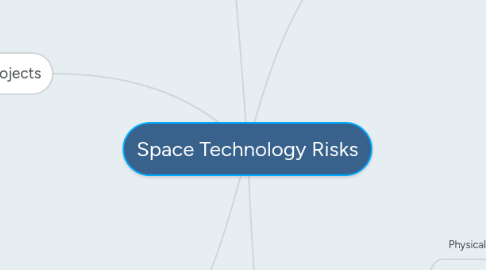
1. Space Projects
1.1. Technological risks
1.1.1. Technology malfunction risks
1.1.2. Intellectual property risks
1.1.2.1. Patents
1.1.3. Software risk
1.1.3.1. Hacking or malware
1.1.3.2. Programming errors
1.2. Funding Risks
1.2.1. Government spending on space technology
1.2.1.1. Political risks
1.2.1.2. Projects are funded by governments that change
1.2.1.3. Government choses to not fund project anymore
1.2.2. Expensive developing space technology
1.2.2.1. Paying employees adequately for the work they are doing
1.2.2.1.1. Employee pay risks
1.2.2.2. Materials and parts are expensive
1.2.2.2.1. Materials and parts can be insured
1.2.3. Need ongoing revenue stream for companies
1.3. Facultative space reinsurance
1.3.1. For underwriters who bears space risks they want to resinsure
1.4. Space product insurance
1.4.1. Coverage to equipment that failed to perform to the manufacturer's specification
2. Timeliness risk
2.1. Traveling space takes a long time
2.1.1. Risks arise with longer lifespans of projects
2.2. Possible to run out of money due to longevity
2.2.1. Excess funding
2.3. Developing technology takes time
2.3.1. Don't want to rush people
2.3.2. Employee risk
2.3.2.1. Managers influence risk
2.4. People don't want to invest when returns are far into future
2.4.1. Government funding
2.4.1.1. Political risk
2.5. Technology goes obsolete fast
2.5.1. New technology costs a lot of money
2.5.2. Must be up to date with technology
2.5.3. Can make an unfinished project obsolete
3. Audience: Insurance company looking to expand their services to space technology
3.1. Reinsurance industry
3.1.1. More competition
3.2. Niche market
3.2.1. Not much competition
3.2.1.1. May be difficult to have competitive prices
3.2.1.2. Large market power
3.2.2. Specific buyers and sellers
3.3. Need lots of information to expand services
4. Satellite Risks and Insurance
4.1. Aviation insurance
4.1.1. Not many companies specifically insure satellites
4.1.2. Many just reinsurance for satellites
4.1.3. Aerospace insurance
4.2. Limited amount of companies provide this niche type of insurance
4.3. Satellite launch and in-orbit insurance
4.3.1. Coverage for:
4.3.1.1. Loss
4.3.1.2. Damage
4.3.1.3. Failure of satellite during launch
4.3.1.4. In-orbit testing
4.3.1.5. In-orbit operation
4.3.2. Third party liability insurance
4.3.2.1. Covers bodily injury and property damage to third parties from the launch and in-orbit activities
4.3.2.2. Employee insurance
4.3.2.2.1. Employee risks
4.4. Satellite transit and pre-launch insurance
4.4.1. Covers damages to satellite while being transported to launch site
4.4.2. Transportation insurance
4.4.2.1. Transportation company risks
4.4.2.2. Third-party automobile risks
4.4.2.3. Automobile insurance
4.4.2.4. Transportation time risks
4.5. Satellite loss of revenue insurance
4.5.1. Coverage for amount of revenue the operator or owner can lose if the satellite doesn't perform to the manufacturer's specification
4.5.2. Lost profits from ineffective satellite
5. Employee risks
5.1. Physical harm while working
5.2. Astronaut risks
5.2.1. Health risks from being in space
5.2.2. On-job and space training risks
5.2.3. Life insurance
5.2.3.1. Risky type of individuals to provide insurance to
5.2.3.2. Considered government emplyees
5.2.3.2.1. Eligible for FEGLI
5.2.3.2.2. Government benefits
5.2.4. Post-space health risks
5.2.4.1. Health insurance
5.3. Meeting objectives and timeliness
5.3.1. Can stress out employee
5.3.2. Make employee feel rushed and make more undetectable errors with technology
5.3.3. Problem solving effectively for employees

